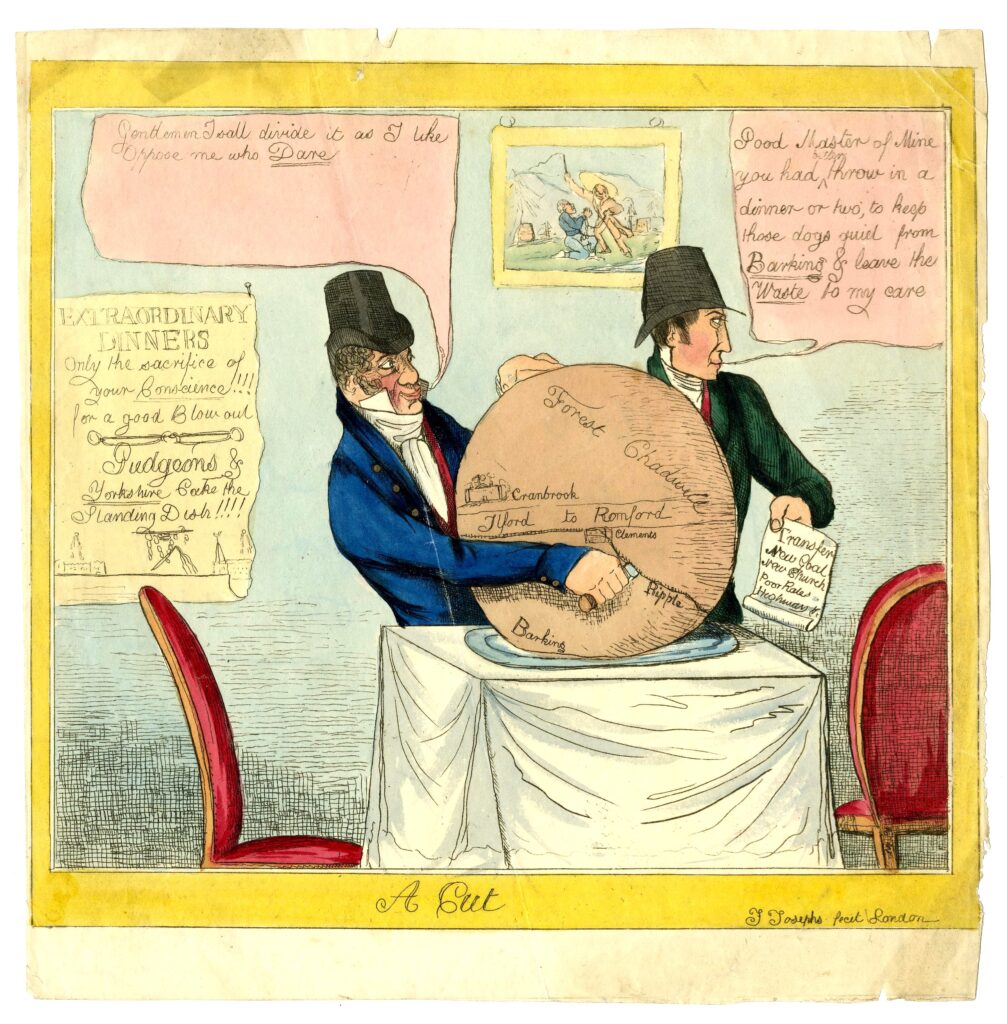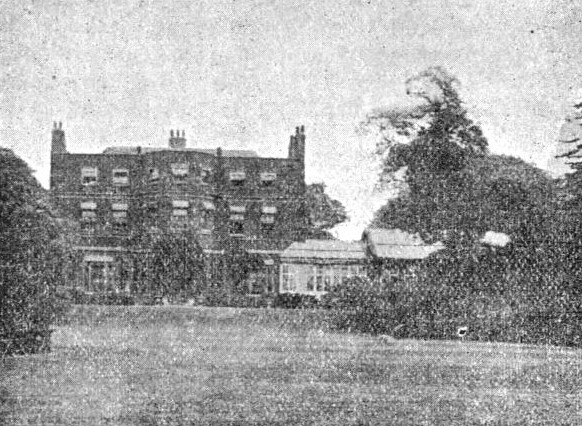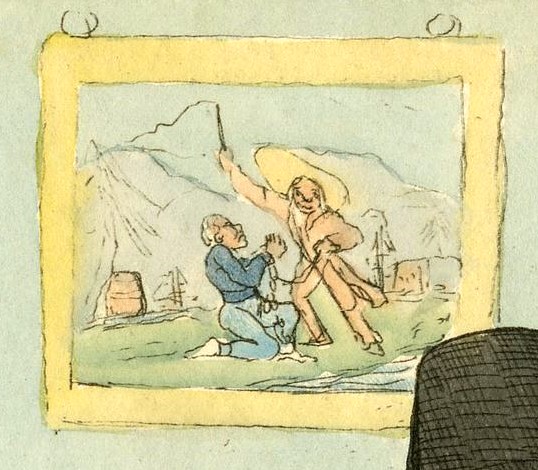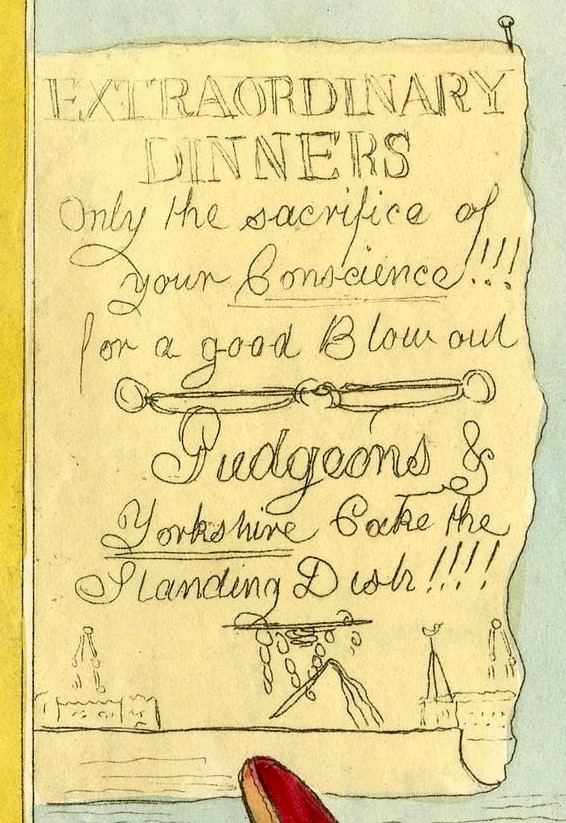
Many thanks to a fan for bringing to our attention (Nov. 2023) a fascinating satirical print/cartoon of Mabel Bent’s paternal grandfather, Robert Westley Hall-Dare (1789-1836), an original of which is in the British Museum. We will never know whether Mabel ever saw a copy – probably not.
The following information about the cartoon is copied from the British Museum’s online catalogue entry (with occasional abbreviations, etc.):
Museum number: 1948,0214.811; Title: ‘A Cut’; Description: Caricature of Robert Westley Hall Dare and another man (variously identified as Sir Thomas Barrett-Lennard or John Thompson) slicing a round pudding labelled ‘Ilford to Romford’, cutting along a line marked Ripple to Clements, with a picture on the wall behind of overseer beating a kneeling slave in chains. c. 1818; Producer name: Print made by: J. (or T.) Josephs; School/style: British; Production date: 1815-1820; Materials: Paper; etching with hand-colouring; Dimensions: Height: 248 mm; width: 244 mm.
See: F. and M.D. George, BM Satires: Catalogue of Political and Personal Satires in the Department of Prints and Drawings in the British Museum (11 vols, 1870-1954, British Museum Publications, London).
Curator’s comments
The date is suggested [1818] … as relating to ‘New Church’, referenced in the paper held in the left hand of the figure on the right [source provided in the online BM caption].
The reference to ‘Dare’ pretty much confirms that: ‘The character on the left is… Robert Westley Hall who became High Sheriff of Essex in 1821. He married into the Dare family but did not adopt his wife’s name by changing his surname to Hall-Dare until 1823. This satire is likely to be later than 1818 – possibly referring to Hall-Dare’s role as High Sheriff but more likely to his 1832 election campaign for South Essex – in which he was successfully elected after coalescing with the Whig candidate Sir Thomas Barrett-Lennard – who may be the other character in red. The satire shows them carving up the constituency to prevent independent candidate (William Pole Tylney Long Wellesley’s re-election)’ [source provided in the online BM caption].
An alternative, and more likely, suggestion (based on the relatively youthful face of the subject) is that: ‘The satirical cartoon referring to Cranbrook, illustrates Robert Westley Hall Dare (MP for South Essex) and John Thompson landowner of neighbouring Clements. Both men were vociferous in the campaign to separate the Great Ilford ward from Barking to make a separate parish of it. The knife is depicted as slicing through Clements in reference to Thompson’s inclosure in 1814 of part of a highway which bisected his estate. The division of the parish was unpopular with many, particularly south Barking landowners, and the cartoon paints both Dare and Thompson as arrogant new landowners, greedy for land and power in the proposed parish. The cartoon, probably instigated by an opponent of south Barking, portrays Hall Dare’s source of wealth (emanating from his father, a West Indian planter) in order to denigrate his character and stain the campaign for division of the parish’ [source provided in the online BM caption].

The place-names are obvious references to the County of Essex (Greater London), large tracts of which were owned and farmed for many decades by the Halls and Dares and associated families. The Hall-Dares were linked to several fine houses in the county for over a century.

For a detailed account of the Dare/Hall-Dare plantations in British Guyana and the compensation paid to the family on Abolition, see the Centre for the Study of the Legacies of British Slavery’s website. This compensation in part funded the move of Mabel Bent’s father (Robert Westley Hall Dare, 1817-1866) to Ireland in the mid 19th century.

The bill of fare pinned up on the left side of the cartoon will have been of caustic relevance at the time (pre 1820s?).
We are to read not ‘Pigeons’, but ‘Gudgeons’ & ‘Yorkshire Cake’. A ‘gudgeon’, as well as a fish, is a credulous or easily fooled person. A ‘Yorkshire Cake’ is a light, fruit cake, and nothing to do with ‘Yorkshire Pudding’. Its significance here is not immediately apparent. The OED has for ‘standing dish’, i.a., ‘standing dish: one that appears each day or at every meal’.
“Lily-white muffins, 0, rare crumpets smoking,/ Hot Yorkshire cakes, hot loaves and charming cakes,/ One-a-penny, two-a-penny, Yorkshire cakes./ What matters to me if great folks run a gadding,/ For politics, fashions, or such botheration;/ Let them drink as they brew, while I merrily bake…” (page 209 from Charles Hindley’s A history of the cries of London. Ancient and modern, 1881, London).
And: “Come buy my gudgeons fine and new…” (page 92 from Charles Hindley’s A history of the cries of London. Ancient and modern, 1881, London).
 Leave a comment or contact us about this article
Leave a comment or contact us about this article
